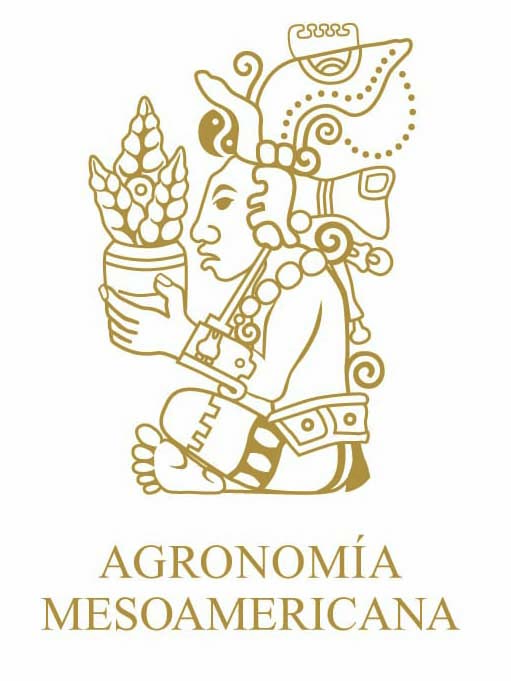Predictive model of the severity of leaf blight by Cercospora kikuchii using meteorological variables
DOI:
https://doi.org/10.15517/am.2023.54430Keywords:
Glycine max, fungus, pathology, plagueAbstract
Introduction. In integrated disease management, it is important to incorporate elements such as economic
damage thresholds, monitoring, and risk forecasting systems, which constitute tools to define disease control strategies. Objective. Develop a predictive model of the severity of Cercospora leaf blight (TFC) using meteorological variables for the north of the province of Buenos Aires, Argentina. Materials and methods. There were data on the incidence
and severity of TFC corresponding to five relevant Pergamino, Buenos Aires, soybean production cycles (2013-2017) in different reproductive stages R1 to R7. The dependent variable was the probability of occurrences of categorized levels of the rate of increase (TI) of the severity of TFC caused by C. kikuchii. The elements and meteorological variables used were daily records of maximum and minimum temperature, precipitation, and relative humidity. The
nonparametric Kendall Tau-b coefficient TI of connection between the TI binary categorized levels of TFC severity and the weather variables was calculated. Results. The meteorological variables with the greatest consequences in relation to the TI of the TFC were those related to relative humidity (DHR, MOJRO, DHRT). The inclusion of a thermal variable (GDTmax) was important for the adjustment of the predictive model. Conclusion. It was possible to develop a TFC severity prediction model that included two meteorological variables, one related to relative humidity
days and another thermal related to a maximum temperature limit for the development of the disease. To validate and strengthen the proposed model, it is necessary to have more severity data over the years.
Downloads
References
Agrios, G. N. (2005). Plant pathology (5th Ed.). Elsevier Academic Press.
Bombelli, E. C. (2011). Modelado para la predicción de enfermedades en cultivos de alto valor comercial [Tesis de Maestría, Universidad Tecnológica Nacional]. Universidad Tecnológica Nacional. http://www.edutecne.utn.edu.ar/tesis/modelado_prediccion_enfermedades.pdf
Carmona, M., Moschini, R., Cazenave, G., & Sautua, F. (2010). Relación entre la precipitación registrada en estados reproductivos de la soja y la severidad de Septoria glycines y Cercospora kikuchii. Tropical Plant Pathology, 35(2), 71-78. https://doi.org/10.1590/s1982-56762010000200001
De Wolf, E. D., & Isard, S. A. (2007). Disease cycle approach to plant disease prediction. Annual Review of Phytopathology, 45(1), 203-220. https://doi.org/10.1146/annurev.phyto.44.070505.143329
El Jarroudi, M., Kouadio, L., Bock, C. H., El Jarroudi, M., Junk, J., Pasquali, M., Maraite, H., & Delfosse, P. (2017). A threshold-based weather model for predicting stripe rust infection in winter wheat. Plant Disease, 101(5), 693-703. https://doi.org/10.1094/pdis-12-16-1766-re
Fehr, W. R., Caviness, C. E., Burmood, D. T., & Pennington, J. S. (1971). Stage of development descriptions for soybeans, Glycine max (L.) Merrill 1. Crop Science, 11(6), 929-931. https://doi.org/10.2135/cropsci1971.0011183x001100060051x
Henderson, D., Williams, C. J., & Miller, J. S. (2007). Forecasting late blight in potato crops of Southern Idaho using logistic regression analysis. Plant Disease, 91(8), 951-956. https://doi.org/10.1094/pdis-91-8-0951
Hughes, G, McRoberts, N., Madden, L. V., & Nelson, S. C. (1997). Validating mathematical models of plant-disease progress in space and time. Mathematical Medicine and Biology, 14(2), 85-112. https://doi.org/10.1093/imammb/14.2.85
Lavilla, M., & Ivancovich, A. (2021). Relación entre enfermedades y rendimiento de granos de soja. Agronomía Mesoamericana, 32(2), 141-148. https://doi.org/10.15517/am.v32i2.44057
Lavilla, M., Ivancovich, A. J., & Díaz-Paleo, A. (2021). Diagrammatic scale for assessment the severity of Cercospora leaf blight on soybean (Glycine max) leaflets. Agronomía Mesoamericana, 33(1), Article 43338. https://doi.org/10.15517/am.v33i1.43338
Lavilla, M., Ivancovich, A., & Díaz-Paleo, A. (2022). Tizón Foliar y la Mancha Púrpura de la semilla causados por Cercospora kikuchii en soja (Glycine max L. Merr.). Agronomía Mesoamericana, 33(3), Artículo 48944. https://doi.org/10.15517/am.v33i3.48494
March, G. J., Oddino, C. M., & Marinelli, A. D. (2010). Manejo de enfermedades de los cultivos según parámetros epidemiológicos (1ª ed.). Biglia Impresores.
Moschini, R. C., Sisterna, M. N., & Carmona, M. A. (2006). Modelling of wheat black point incidence based on meteorological variables in the southern Argentinean Pampas region. Australian Journal of Agricultural Research, 57(11), 1151-1156. https://doi.org/10.1071/ar05275
Montes, C., Ghulam Hussain, S., & Krupnik, T. J. (2022). Variable climate suitability for wheat blast (Magnaporthe oryzae pathotype Triticum) in Asia: results from a continental-scale modeling approach. International Journal of Biometeorology, 66(11), 2237-2249. https://doi.org/10.1007/s00484-022-02352-9
Yadav, R., Bharti, O., Pandya, R. K., Thakur, M. P., & Yadav, A. (2016). Correlation study of individual meteorological parameters and disease severity for prediction of pearl millet blast. International Journal of Current Research, 8(11), 41580-41582. http://www.journalcra.com/article/correlation-study-individual-meteorological-parameters-and-disease-severity-prediction-pearl
Downloads
Additional Files
Published
How to Cite
Issue
Section
License
Copyright (c) 2023 M. Lavilla, M. Martínez, A. Ivancovich, A. Díaz-Paleo

This work is licensed under a Creative Commons Attribution-NonCommercial-NoDerivatives 4.0 International License.
1. Proposed policy for open access journals
Authors who publish in this journal accept the following conditions:
a. Authors retain the copyright and assign to the journal the right to the first publication, with the work registered under the attribution, non-commercial and no-derivative license from Creative Commons, which allows third parties to use what has been published as long as they mention the authorship of the work and upon first publication in this journal, the work may not be used for commercial purposes and the publications may not be used to remix, transform or create another work.
b. Authors may enter into additional independent contractual arrangements for the non-exclusive distribution of the version of the article published in this journal (e.g., including it in an institutional repository or publishing it in a book) provided that they clearly indicate that the work was first published in this journal.
c. Authors are permitted and encouraged to publish their work on the Internet (e.g. on institutional or personal pages) before and during the review and publication process, as it may lead to productive exchanges and faster and wider dissemination of published work (see The Effect of Open Access).
























